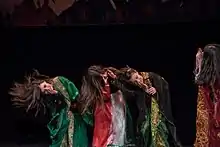
A group of Emiratis perform the traditional yowlah 'stick dance' during a show at Sheikh Zayed Palace Museum in Al Ain

Arab girls dancing Khaleegy
The traditional dances of the Middle East (Arabic: رقص شرق أوسطي) (also known as Oriental dance) span a large variety of folk traditions throughout North Africa, the Middle East, and Central Asia.
For detailed information on specific dances of the region, see the main entries as follows:
- Arab dance: Ardah, Baladi, Belly dance, Dabke, Deheyeh, Fann at-Tanbura, Khaleegy, Mizmar, Raqs sharqi, Shamadan, Tahtib, Tanoura, Yowlah
- Assyrian folk dance: Khigga
- Kurdish dance: Dilan
- Persian dance: Classical Persian dance
- Turkish dance: Çiftetelli, Halay
- Jewish dance: Hora, Tza'ad Teimani, Israeli Folk Dances
Western dance is being incorporated in the Middle East.[1]
See also
References
External links
Wikimedia Commons has media related to Dances of the Middle East.
This article is issued from Wikipedia. The text is licensed under Creative Commons - Attribution - Sharealike. Additional terms may apply for the media files.
.svg.png.webp)